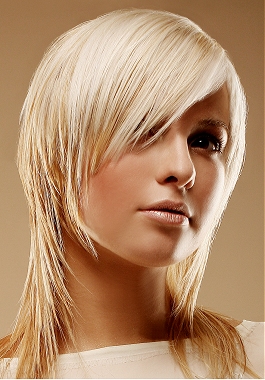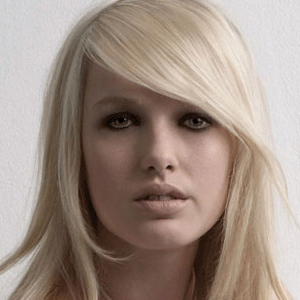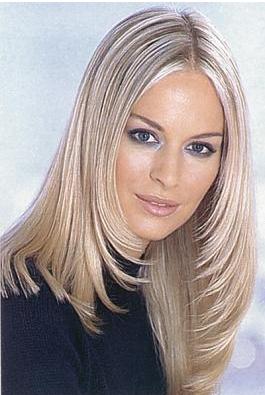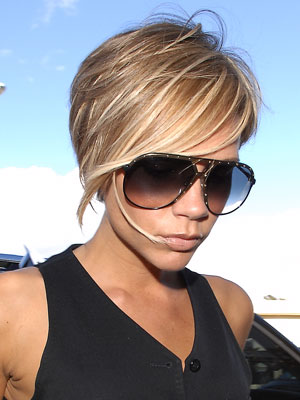The word blond is first attested in English in 1481 and derives from Old French blund, blont meaning "a colour midway between golden and light chestnut". It gradually eclipses the native term fair, of same meaning, from Old English fæġer, to become the general term for "light complexioned". The French (and thus also the English) word blond has two possible origins. Some linguists say it comes from Medieval Latin blundus, meaning yellow, from Old Frankish *blund which would relate it to Old English blonden-feax meaning grey-haired, from blondan/blandan meaning to mix (Cf. blend). Also, Old English beblonden meant dyed as ancient Germanic warriors were noted for dying their hair.
However, other linguists who favor a Latin origin for the word say that Medieval Latin blundus was a vulgar pronunciation of Latin flavus, also meaning yellow. Most authorities, especially French, attest the Frankish origin. The word was reintroduced into English in the 17th century from French, and was for some time considered French; in French, "blonde" is a feminine adjective; it describes a woman with blond hair.
"Blond" and "blonde", with its continued gender-varied usage, is one of few adjectives in written English to retain separate masculine and feminine grammatical genders. Each of the two forms, however, is pronounced the same way. American Heritage's Book of English Usage propounds that, insofar as "a blonde" can be used to describe a woman but not a man who is merely said to possess blond(e) hair, the term is an example of a "sexist stereotype [whereby] women are primarily defined by their physical characteristics." The Oxford English Dictionary records that the phrase "big blond beast" was used in the 20th century to refer specifically to men "of the Nordic type" (that is to say, blond-haired). Particularly this had associations with Friedrich Nietzsche's Übermensch. The OED also records that blond as an adjective is especially used with reference to women, in which case it is likely to be spelt "blonde", citing three Victorian usages of the term. The masculine version is used to describe a plural, in "blonds of the European race", in a citation from 1833 Penny cyclopedia, which distinguishes genuine blondness as a Caucasian feature distinct from albinism. By the early 1990s, "blonde moment" or being a "dumb blonde" had come into common parlance to mean "an instance of a person, esp. a woman... being foolish or scatter-brained." Another hair color word of French origin, brunet(te), also functions in the same way in orthodox English. The OED gives "brunet" as meaning "dark-complexioned" or a "dark-complexioned person", citing a comparative usage of brunet and blond to Thomas Henry Huxley in saying, "The present contrast of blonds and brunets existed among them". "Brunette" can be used, however, like "blonde", to describe a mixed-gender populace. The OED quotes Grant Allen, "The nation which resulted..being sometimes blonde, sometimes brunette."
"Blond" and "blonde" are also occasionally used to refer to objects that have a color reminiscent of fair hair. Examples include pale wood and lager beer. For example, the OED records its use in 19th century poetic diction to describe flowers, "a variety of clay ironstone of the coal measures", "the colour of raw silk", and a breed of ray.
Many sub-categories of blond hair have also been defined to describe someone with blond hair more accurately. Common examples include the following:
Natural lighter hair colors occur most often in Europe and less frequently in other areas. In northern European populations, the occurrence of blond hair is very frequent. The hair color gene MC1R has at least seven variants in Europe giving the continent a wide range of hair and eye shades. Based on recent genetic research carried out at three Japanese universities, the date of the genetic mutation that resulted in blond hair in Europe has been isolated to about 11,000 years ago during the last ice age.
A typical explanation found in the scientific literature for the evolution of light hair is related to the requirement for vitamin D synthesis and northern Europe's seasonal deficiency of sunlight. Lighter skin is due to a low concentration in pigmentation, thus allowing more sunlight to trigger the production of vitamin D. In this way, high frequencies of light hair in northern latitudes are a result of the light skin adaptation to lower levels of sunlight, which reduces the prevalence of rickets caused by vitamin D deficiency. The darker pigmentation at higher latitudes in certain ethnic groups such as the Inuit is explained by a greater proportion of seafood in their diet. As seafood is high in vitamin D, vitamin D deficiency would not create a selective pressure for lighter pigmentation in that population.
An alternative hypothesis was presented by Canadian anthropologist Peter Frost, under the aegis of University of St Andrews, who published a study in March 2006 in the journal Evolution and Human Behavior. Frost said blond hair evolved very quickly in a specific area at the end of the last ice age by means of sexual selection. According to the study, the appearance of blond hair and blue eyes in some northern European women made them stand out from their rivals at a time of fierce competition for scarce males. The study argues that blond hair was produced higher in the Cro-Magnon descended population of the European region because of food shortages 10,000-11,000 years ago following the last glacial period when most of it was covered by steppe-tundra. Almost the only sustenance in northern Europe came from roaming herds of mammoths, reindeer, bison and horses and finding them required long, arduous hunting trips in which numerous males died, leading to a high ratio of surviving women to men. This hypothesis argues that women with blond hair posed an alternative that helped them mate and thus increased the number of blonds. A theory propounded in The History and Geography of Human Genes (1994), says blond hair became predominant in Northern Europe beginning about 3,000 BC, in the area now known as Lithuania, among the recently arrived Proto-Indo-European settlers (according to the Kurgan hypothesis), and the trait spread quickly through sexual selection into Scandinavia. As above, the theory assumes that men found women with blond hair more attractive. Blond hair is most frequently found among the populations of Northern Europe. The pigmentation of both hair and eyes is lightest around the Baltic Sea and their darkness increases regularly and almost concentrically around this region. Strawberry blond is a much rarer type containing the most amounts of pheomelanin. It is also predominant in Australia, Canada and the United States amongst the descendents of the Northern European immigrants. Blond hair in Europeans is also found in smaller numbers in the rest of Europe and Latin America, especially southern Brazil, Argentina and Chile. A 2009 study found that light hair colors were already present in southern Siberia during the Bronze Age. Due to migration from Europe from the 16th to the 20th centuries, blonds are also found all around the world such as in North America, South America, Australia, New Zealand, South Africa etc.
However, other linguists who favor a Latin origin for the word say that Medieval Latin blundus was a vulgar pronunciation of Latin flavus, also meaning yellow. Most authorities, especially French, attest the Frankish origin. The word was reintroduced into English in the 17th century from French, and was for some time considered French; in French, "blonde" is a feminine adjective; it describes a woman with blond hair.
"Blond" and "blonde", with its continued gender-varied usage, is one of few adjectives in written English to retain separate masculine and feminine grammatical genders. Each of the two forms, however, is pronounced the same way. American Heritage's Book of English Usage propounds that, insofar as "a blonde" can be used to describe a woman but not a man who is merely said to possess blond(e) hair, the term is an example of a "sexist stereotype [whereby] women are primarily defined by their physical characteristics." The Oxford English Dictionary records that the phrase "big blond beast" was used in the 20th century to refer specifically to men "of the Nordic type" (that is to say, blond-haired). Particularly this had associations with Friedrich Nietzsche's Übermensch. The OED also records that blond as an adjective is especially used with reference to women, in which case it is likely to be spelt "blonde", citing three Victorian usages of the term. The masculine version is used to describe a plural, in "blonds of the European race", in a citation from 1833 Penny cyclopedia, which distinguishes genuine blondness as a Caucasian feature distinct from albinism. By the early 1990s, "blonde moment" or being a "dumb blonde" had come into common parlance to mean "an instance of a person, esp. a woman... being foolish or scatter-brained." Another hair color word of French origin, brunet(te), also functions in the same way in orthodox English. The OED gives "brunet" as meaning "dark-complexioned" or a "dark-complexioned person", citing a comparative usage of brunet and blond to Thomas Henry Huxley in saying, "The present contrast of blonds and brunets existed among them". "Brunette" can be used, however, like "blonde", to describe a mixed-gender populace. The OED quotes Grant Allen, "The nation which resulted..being sometimes blonde, sometimes brunette."
"Blond" and "blonde" are also occasionally used to refer to objects that have a color reminiscent of fair hair. Examples include pale wood and lager beer. For example, the OED records its use in 19th century poetic diction to describe flowers, "a variety of clay ironstone of the coal measures", "the colour of raw silk", and a breed of ray.
 of blonde-haired children. |  Greg Apodaca\x26#39;s Digital |  Blonde Hair |  A nice blonde goes into an |  blonde-hair-stylist-salons- |
 Hairstyle and Fashion: blonde |  Blondes blonde hair |  Blonde Hairstyles at My New |  Blonde Hairstyles at My New |  Kim Kardashian Blonde — Kim |
A typical explanation found in the scientific literature for the evolution of light hair is related to the requirement for vitamin D synthesis and northern Europe's seasonal deficiency of sunlight. Lighter skin is due to a low concentration in pigmentation, thus allowing more sunlight to trigger the production of vitamin D. In this way, high frequencies of light hair in northern latitudes are a result of the light skin adaptation to lower levels of sunlight, which reduces the prevalence of rickets caused by vitamin D deficiency. The darker pigmentation at higher latitudes in certain ethnic groups such as the Inuit is explained by a greater proportion of seafood in their diet. As seafood is high in vitamin D, vitamin D deficiency would not create a selective pressure for lighter pigmentation in that population.
 Blonde Emo Girl Hairstyles |  Blonde Scene Hair Hairstyles |  blonde hair dye |  Blonde Hair Colors | New Hair |  She Went Blonde – Style |
 Posts Tagged \x26#39;blonde emo girl |  blonde with long straight hair |  blonde - photo/picture |  Blonde Scene Hair Hairstyles |  Famous Dark Blondes |

No comments:
Post a Comment